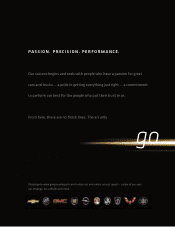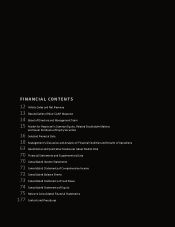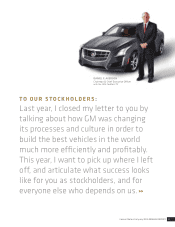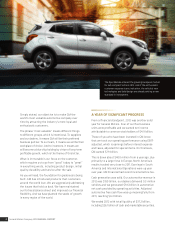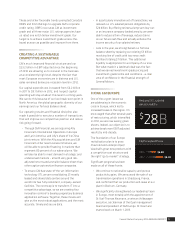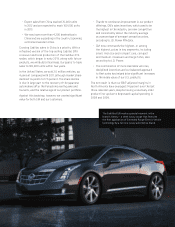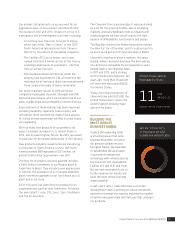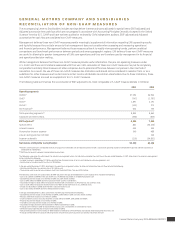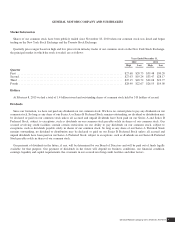General Motors 2012 Annual Report Download - page 8
Download and view the complete annual report
Please find page 8 of the 2012 General Motors annual report below. You can navigate through the pages in the report by either clicking on the pages listed below, or by using the keyword search tool below to find specific information within the annual report.
5
General Motors Company 2012 ANNUAL REPORT
These and other favorable trends prompted Canada’s
DBRS and Fitch Ratings to upgrade GM’s corporate
credit rating. DBRS now rates GM as investment
grade and all three major U.S. ratings agencies have
us rated one notch below investment grade. Our
target is to achieve investment grade across-the-
board as soon as possible and improve from there.
CREATING A SUSTAINABLE
COMPETITIVE ADVANTAGE
GM’s much improved financial structure and our
$23.2 billion in EBIT-adjusted since the beginning
of 2010 are allowing us to reinvest in the business
at a consistently high level, despite the fact that
most European economies are in distress and U.S.
sales remained below pre-recession levels in 2012.
Our capital expenditures increased from $6.2 billion
in 2011 to $8.1 billion in 2012, and I expect capital
spending will stay at about this level in coming years.
We can do this because of our low break-even point in
North America, the global geographic diversity of our
earnings and our fortress balance sheet.
Our operating results and financial discipline also
made it possible to execute a number of transactions
that will improve our competitive position and reduce
risk going forward.
•Through GM Financial, we are acquiring Ally
Financial’s International Operations in Europe
and Latin America, and Ally’s share of its China
joint venture. With the Ally acquisitions and GM
Financial’s other new business initiatives, we
will be able to provide financing in markets that
represent 80 percent of our sales volume. We
will also be able to meet demand in strategic and
underserved markets – all with very good risk-
adjusted returns and a smaller balance sheet than
other captive automotive finance companies.
•To ensure GM has state-of-the-art information
technology (IT), we are consolidating 23 mostly
leased and shared data centers around the
world into two fully redundant, company-owned
facilities. The next step is to transform IT into a
competitive advantage, so we are creating four
innovation centers to develop proprietary business
application software. Together, these moves will
give us the most robust applications, and the most
accurate, timely and secure data.
• In a particularly innovative set of transactions, we
reduced our U.S. salaried pension obligations by
$28 billion. By offering retirees a lump sum buy-out
or an insurance company-backed annuity, we were
able to reduce a form of leverage, reduce claims
on our future cash flow and actually enhance the
income security of our salaried retirees.
• Late in the year, we strengthened our fortress
balance sheet by replacing our existing $5 billion
revolving line of credit with two new credit
facilities totaling $11 billion. This additional
liquidity is appropriate for a company of our size.
But what made it a landmark deal was the fact
that we earned investment-grade pricing and
investment-grade terms and conditions – a clear
vote of confidence in the financial strength of
General Motors.
FIXING GM EUROPE
One of the urgent issues we
are addressing is the economic
crisis in Europe, which led to
increased losses in the region. I’m
encouraged that after several years
of restructuring, which intensified
in 2012, we are now seeing green
shoots. Indeed, our objective is to
achieve break-even EBIT-adjusted
results by mid-decade.
The foundation of our Europe
revitalization plan is to grow
Chevrolet and underpin Opel/
Vauxhall’s great new products with
a competitive cost structure and
the right “go to market” strategy.
Significant progress has been
made on all of these fronts:
•We continue to rationalize capacity and pursue
productivity gains. We announced the sale of our
transmission operations in Strasbourg, France,
and confirmed that car production will cease at our
plant in Bochum, Germany.
•We significantly strengthened our leadership team
in Europe, most notably with the appointment of
Dr. Karl-Thomas Neumann, a veteran Volkswagen
executive, as chairman of the Opel management
board and president of GM Europe. Dr. Neumann
started work on March 1, 2013.
$28B
Reduced U.S. salaried
pension liability
Capital expenditures
2011 $6.2B
$8.1B
2012




